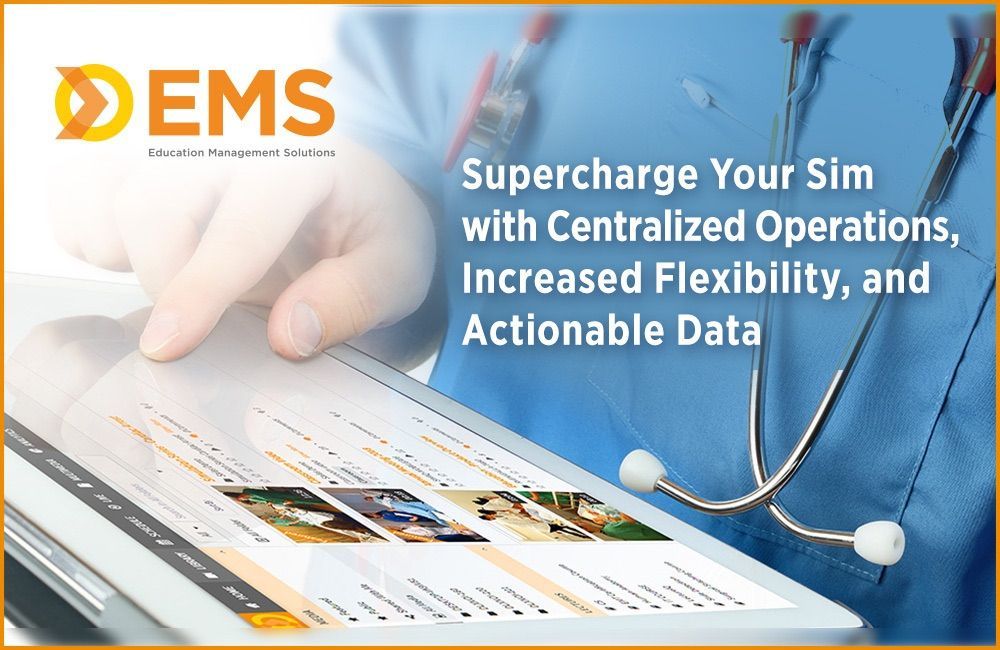EMS Supercharge Your Sim with Centralized Operations, Increased Flexibility, and Actionable Data
To address the need to train more healthcare providers smarter, not harder, Education Management Solutions (EMS) can supercharge a simulation center with centralized operations, increased flexibility, and actionable data. For decades, healthcare simulation has been an essential component in the preparation of highly qualified practitioners to move into professional clinical practice. From increased patient safety and decreased medical errors, to improved communication and sounder interprofessional team development, simulation offers a multitude of benefits whether clinical simulation occurs in a sim lab, in-situ, the field, or virtually. This HealthySimulation.com article discusses solutions to improve the process of medical simulation.
The healthcare landscape is rapidly evolving. While the pandemic’s long-term ramifications on the medical field are yet to be seen, it’s clear that new and increased strains on an already taxed healthcare system have left many healthcare institutions struggling. Quality, skilled caregivers have retired from practice due to burnout, exhaustion, and excessive overtime hours, and escalated patient safety threats. Environmental factors, emerging technologies and treatment modalities, and changes in patient care delivery have caused healthcare education institutions to struggle to keep up with the demand.
Now is the time for educators embrace intelligent new solutions to face challenges head-on, whether by deploying open-system technology to centralize and streamline operations, creating efficiencies for administrators and faculty, incorporating more flexibility and opportunities for learners, and eliminating data silos to provide actionable intelligence through more meaningful analytics and Key Performance Indicator (KPI) tracking.
Sponsored Content:
Read on to examine these challenges and explore how simulation in a healthcare program can leverage innovative strategies to thrive now—and in the future. EMS has solutions.
1. Streamline Multisource Data
How many platforms, apps, programs, and technologies are used to run a program’s simulation training activities? Are they interconnected?
Healthcare training programs require enhanced efficiency and extensibility to succeed in the evolving educational landscape. Flexible simulation technology streamlines and connects multisource data that helps educators improve operations, prepare for growth, secure data, decrease dependence on internal IT, maximize return on investment (ROI), and seamlessly switch between in-person and virtual learning environments.
Sponsored Content:
Break the data free from silos. With training program data interconnectivity within a single management interface, it is possible to collect and compare metrics from multiple sources. Educators can track learner and program performance across key competencies, examine data to ensure training and assessment models function effectively, and aggregate data from multiple assessment systems. Whether training occurs on-site at a simulation center, in the field, or remotely, centralized data allows educators to get the information needed, when they need it, and manage the full scope of their simulation program operations within a streamlined interface.
2. Provide More Flexibility to Learners
Healthcare simulation has taken on a vital role in replicating real-world case scenarios to empower learners to make clinical decisions across various patient care situations while experiencing realistic outcomes and consequences. It is essential for learners to have the freedom and flexibility to train, assess, and make mistakes in a safe, controlled training environment to gain the confidence they need to successfully transition into professional practice.
In the future, educators and administrators should look beyond the sim lab to meet learners’ needs by removing geographic barriers to learning. Even before COVID-related campus closures drove learning online at numerous institutions, there was a demand for rapid adoption of flexible learning curricula, and learners sought out opportunities for remote and hybrid learning. Flexible simulation technology is equipped to navigate the changing higher education landscape, allowing educators to conduct high-impact standardized patient (SP) encounters and simulation sessions in a fully online environment. Simulation also helps programs meet the critical need to practice clinical treatment in a telemedicine format while providing learners with the flexibility they need and expect.
3. Deliver Actionable Intelligence
The learners are approaching graduation—but are they ready to treat actual patients? Competency-based education focuses on outcomes and learner achievement centered on continuous, longitudinal performance assessments across national core competencies. It also incorporates hands-on or virtual education focused on mastery of key competencies that ensure learners develop the skills they need to succeed in real-world clinical practice.
Integrated technologies play an important part in helping educators take the guesswork out of curriculum mapping to deliver an integrated, longitudinal performance view to learners and leadership. Plus, technology gives educators more power than ever to confirm training curricula are meeting learners’ needs, ensuring they’re prepared for post-undergraduate clinical practice. It’s easy to deploy advanced, real-time tracking to ensure learners are meeting certain competencies, localize problem areas, and deliver actionable intelligence from a single dashboard.
4. Centralize Virtual/Hybrid Infrastructures
Education does not end after graduation. Practicing clinicians must regularly complete ongoing training to maintain accreditation, develop team communication, and ensure even rarely used skills remain sharp through repeated practice. Flexible simulation technology facilitates training even in the heart of high-stakes hospital environments. From hyper-realistic in-situ scenarios to full-scale virtual/hybrid learning infrastructures within increasingly interconnected landscapes, simulation helps to open more doors with interprofessional and continuing adult education, as well as increase buy-in and participation by making it as easy as possible for practitioners to make time for training exercises in their daily schedules.
5. Train Smarter, Not Harder
Recent reports by the U.S. Department of Health and Human Services show that healthcare staffing shortages, already a growing problem pre-COVID, have become increasingly severe nationwide, with hospitals in some states experiencing up to 50 percent staff shortages this year.
This news is unfortunate for patients and practitioners alike. Whether due to illness, burnout, retirement, or general workforce attrition, healthcare staffing shortages place ever greater demand on the remaining practitioners to care for more patients with less support. Staffing shortages also actively endanger patient safety and can lead to medical errors and longer wait times, even during emergencies—and the problem is only getting worse.
To meet the growing need for qualified practitioners, as well as rapidly develop, educate, and scale critical lifesaving medical protocols to meet emergent national healthcare threats, programs can partner with a trusted vendor to deploy leading-edge technology that helps prepare learners for real-world practice faster and more effectively. By training “smarter, not harder,” educators can use in-person, virtual, and hybrid flexible simulation to supplement clinical instruction. With healthcare simulation, learners gain mastery through repetition, overcome deficiencies, and graduate on time with the skills they need to fill key frontline provider roles where they are needed most.
More About Education Management Solutions (EMS)
EMS’ healthcare simulation-based solutions for healthcare training environments range from clinical simulation management software and hardware to counselor education and virtual interactive computer-based training tools. Further, EMS’ comprehensive technology platform aggregates curriculum and learner performance data across online, didactic, clinical, and simulation-based training modules.
Since its founding in 1994, EMS’ mission has been to provide a safe environment for healthcare professionals to develop patient care skills. The company feels strongly that its state-of-the-art technology makes simulation training even easier, from automated training sessions to feature-rich, interactive tools in the simulation classroom and mobile solutions for in-situ training environments.
Learn More About Education Management Solutions!
Teresa Gore, PhD, DNP, APRN, FNP-BC, CHSE-A, FSSH, FAAN – Dr. Gore has experience in educating future nurses in the undergraduate and graduate nursing programs. Dr. Gore has a PhD in Adult Education, a DNP as a family nurse practitioner, and a certificate in Simulation Education. Dr. Gore is an innovative, compassionate educator and an expert in the field of healthcare simulation. In 2007l Teresa started her journey in healthcare simulation. She is involved in INACSL and SSH. She is a Past-President of INACSL and is a Certified Healthcare Simulation Educator Advanced (CHSE-A). In 2018, she was inducted as a Fellow in the American Academy of Nursing (FAAN). In 2021, she was inducted as a Fellow in the Society of Simulation in Healthcare Academy (FSSH) and selected as a Visionary Leader University of Alabama at Birmingham School of Nursing Alumni. During her career, Dr. Gore has led in the development and integration of simulation into all undergraduate clinical courses and started an OSCE program for APRN students. Her research interests and scholarly work focus on simulation, online course development and faculty development. She has numerous invited presentations nationally and internationally on simulation topics.
Sponsored Content:


















